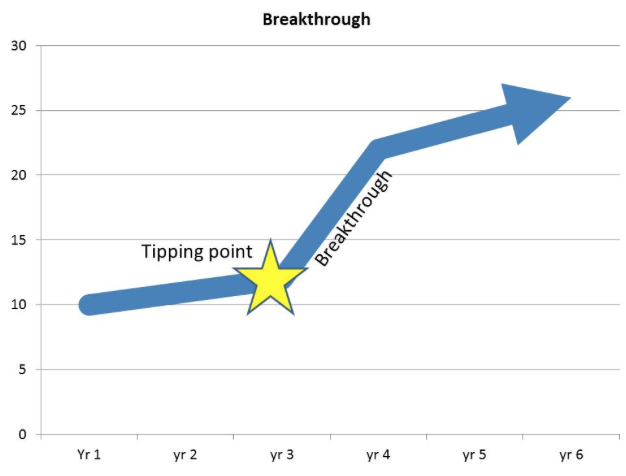The four places to look if you want to create a franchise sales breakthrough
By Joe Mathews
Want to create a breakthrough for franchisee recruitment results for your franchise company?
Let me start by defining the phrase franchisee recruitment breakthrough.
Breakthrough, by definition, is an unpredictable result. Here’s an example: if in year 1 you recruited 10 franchisees, in year 2 you recruited 11 franchisees, and in year 3 you recruited 12 franchisees. What is predictable for year 4? Wouldn’t 13 franchisees come to mind?
Except in year 4 you recruit 24 franchisees. That’s what a breakthrough looks like. The point at which the breakthrough occurs is called “the tipping point.” The tipping point is the exact moment when the past goes into past and a new future becomes possible. The million dollar-question is: “What happens in the elbow of the hockey stick on the chart? What creates that franchisee recruitment tipping point?”

A tipping point is created only if the franchisor has two foundational pillars solidly in place:
Pillar 1. Strong unit level economics.
The franchisor does not get to say whether or not the business model produces strong returns; existing franchisees and franchise candidates do. Franchise candidates have expectations for cash flow, return on investment, cash-on-cash return — or however they measure financial results. The business model has to meet or exceed those objectives if the chain is to grow. If 80% or more of franchisees are not meeting or exceeding their financial objectives, you’ve got an operational problem, not a franchise sales problem.
Pillar 2. Solid franchisee-franchisor relationships.
Franchisees must trust the franchisor’s intentions and be willing to be led by the franchisor. If a minimum of 80% of your franchisees aren’t saying, “Knowing what I know now, would I make that same decision again,” if they don’t tell your franchise candidates that they have a trusting relationship with you as a franchisor, you do not have a franchise sales problem. You have a corporate culture problem that may be disguising itself as a sales problem, because it’s killing your franchise sales results.
Assuming you have those pillars solidly in place, your chain will create a breakthrough. It’s not a function of “if,” but “when.” Achieving that breakthrough is a highly predictable outcome, but the timing of that breakthrough is not.
The Four Franchisee Recruitment Breakthrough Strategies:
There are four strategies that, when skillfully implemented together, create the synergy necessary to bring about a tipping point and a breakthrough.
Strategy One: Lead Generation (or as Franchise Performance Group says, “a franchise buyer generation strategy”)
Franchisors have to have a cost-effective, proven strategy for attracting buyers who are a fit for the business. Such a strategy is composed of two key elements. First, franchisors must know the profile of a successful franchisee. Second, they must have a business model that produces the financial rewards, the quality of work and the quality of life benefits that target franchisee values. Your franchise buyer generation strategy is your chain’s method of articulating your value in a way that it gets found and resonates with your target franchise candidates. Franchise Performance Group defines “cost effective” as on-boarding new franchisees for an average of $10,000 in advertising expenditures per franchisee. That may vary from individual to individual, depending on the source of the franchise buyer. (Getting a referral from an existing franchisee costs very little, while a franchise broker network is pricey.) Your average cost for acquiring a franchisee should range from $8,000-12,000 exclusive of franchise broker networks which would be $20 thousand or more.
Strategy Two: Employ a top-performing franchise recruiter.
After attending the IFA and Franchise Update conference each year, I come away thinking that most franchise sales people are mediocre at best and don’t seem committed to mastering their craft. There is a huge results dividend in employing those who are. If you talk to franchise sales VPs of larger companies that manage franchise sales forces, you’re going to hear again and again that the top-performing franchisee recruiters are outperforming the marginal guys by 200% to 300%, even though they all have the exact same lead flow. The leads are the constant, it’s the recruiter skills that are the variable. A “master of the craft” franchisee recruiter takes 30-90 days to learn the nuances of a particular franchisor and fill up their pipeline. Within 4-6 months, they will do what they always do, which is to crush the franchise sales results of their peer group by 100%-200%. Don’t confuse experience with the ability to perform – the majority of salespeople in the franchise industry underperform and length of time in the industry can often mean bad habits and a lack of performance.
Strategy Three: Design and implement a detailed, content-rich franchisee recruitment process.
This process has to accomplish three things:
- First, the franchise candidate needs to be able to clearly see how they can achieve their desired results with the franchise.
- Second, the franchisor needs to clearly see whether the candidate is a culture fit who stands a high probability of winning, according to the franchise candidate’s definition of winning.
- Lastly, the process has to be consistent with how franchise candidates buy businesses. A well-thought-out, step-by-step, well-articulated franchise sales process will close some of the performance gap between the top performing franchisees and the middle and underperforming franchisee recruiters.
A good franchise sales process will actually push the bottom level of recruiter performance toward the top. It won’t get the mediocre to a level of mastery, but it will create a sustainable acceptable result.
Strategy Four: Skilled leadership at the VP or National Director level.
A skilled leader will be working behind the scene coaching, training, and marshaling resources and removing barriers to growth. The first thing a strong leader must do is measure and track key results. There are four things you want to measure: pipeline status, pipeline activity, conversion ratios, and cost.
Status is what’s in the pipeline right now – a list of candidates with lead source, date of opt in and current sales status. We use a weekly pipeline report for this – a simple, one page spreadsheet that has all the metrics and pipeline at a glance. We don’t drag unnecessary data into our pipeline conversations and spend time focusing on strategy for each serious candidate, reviewing what happened the week before and setting goals for each for the week ahead. Companies like Franconnect offer strong automated solutions.
Activity level is what happened — this week? month? year-to-date? How does that compare to previous periods? How many leads are we getting? How many webinars or interviews? How many apps? Tracking the activity helps you understand when you are performing at an acceptable level. As the recruiters from the Dwyer Group are fond of saying ‘in the absence of sales, measure all sales activity.’ We couldn’t agree more!
Conversions are like batting averages. How effective are we at moving candidates through various stages of the process and into signing agreements? A breakdown in the beginning of the pipe (like a 30% lead reach rate) may mean your website and content strategy are not creating the necessary engagement level to break down barriers of communication. Or perhaps your lead follow up is ineffective. A breakdown in the middle of the pipe generally means candidates have not connected to the brand story and do not see how their needs can be meet as a franchisee of your system. A breakdown in the end is generally either an issue with franchisee validation or an ineffective franchisee recruiter. Typically, you should be measuring the following:
- % of leads contacted
- % of leads that make it to the first major interview or webinar
- % of leads that fill out an application or RFC with financial qualification info
- % of leads that make it to discovery day
- % of leads that purchase
- % of applicants that purchase
Of these the first two are the least measured, even though they can determine the outcome more than other metrics. Tracking the early pipeline activity can often create a breakthrough because they uncover lack of response, messaging issues or sales skills problems that many teams miss.
Cost. What’s your cost for acquiring a lead? What’s your cost for acquiring a qualified applicant? Most importantly, what’s your cost for acquiring a franchisee, which we said should average between $8,000-$12,000.
The franchisee recruitment department leader should be able to create effective pipeline reviews, not just of who is in the pipeline, but of how franchise sales people can get people effectively from point A to point B.
Summary
First, you need cost-effective lead generation. The second element is skilled recruiters. Then comes a strong, and well-articulated franchise sales process. And lastly, and effective leader owning key results, coaching and training staff, and leading the charge.
When we consult with a company, we look at all four of these areas. Each can keep an otherwise-worthy company from creating a breakthrough. Often franchisors misdiagnose their issues as lead generation problems when it is an unskilled recruiter, a broken sales process or ineffective management creating the logjam.
It takes all four of these areas working in concert to create a breakthrough, and if you miss one or more, you are just about guaranteed to hit a wall.
Curious about how your company stacks up in any of these areas? Get an outside perspective and make sure there are not areas you can shore up. A little work at the outset can create a huge payoff in the long run.
